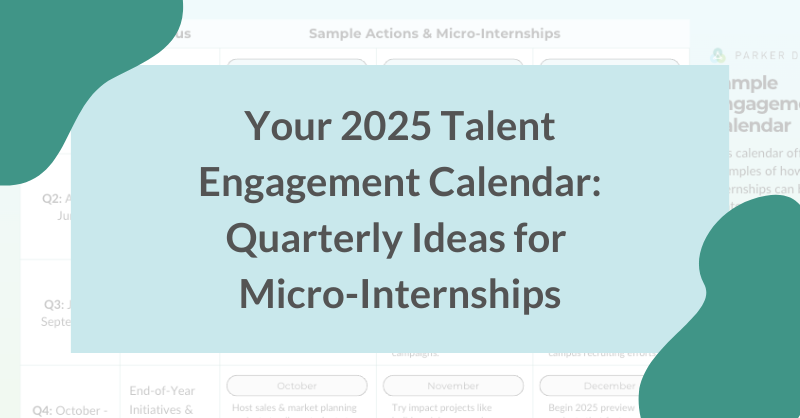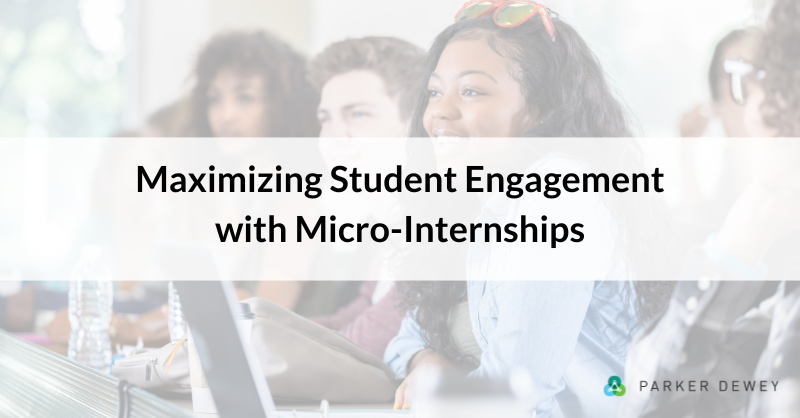
Your 2025 Talent Engagement Calendar [DOWNLOAD]: Quarterly Ideas for Micro-Internships
Recruiting and nurturing early-career talent doesn’t have to be limited to peak seasons. Micro-Internships—short, project-based assignments—offer a practical way to connect with potential hires, assess their skills, and create ongoing relationships throughout the year. By strategically using project-based work, you can build relationships, evaluate skills, and ensure that when hiring needs arise, you have a warm pipeline of ready-to-hire candidates.
This sample calendar outlines how you can leverage Micro-Internships at different points in the year to suit your specific needs. Whether you decide to engage talent once a quarter or use multiple touchpoints year-round, this guide offers a variety of options to keep top talent engaged on your terms.
<< Download your sample 2025 talent engagement calendar>>
Quarter 1: Laying the Foundation & Early Identification
Kick off the year by setting the stage for ongoing engagement with early-career talent. In January, leverage Micro-Internships to invite students to provide fresh perspectives on industry trends, help map out strategic priorities, or contribute ideas for early projects. These early assignments help candidates get familiar with your organization’s goals and culture and give you a chance to engage curious, proactive talent.
February is an ideal time for marketing & content strategy projects, where students tackle real or hypothetical scenarios that let you observe creative problem-solving and how they interpret your brand’s voice. By March, run a skills assessment challenge with projects in data, finance, or marketing to help you identify top talent before recruiting ramps up, building early relationships that may translate into future roles.
Quarter 2: Internship Auditions & Summer Support
From April to June, focus on internships and nurturing a pipeline for future hires. In April, internship auditions—short, project-based assignments—are an effective way to evaluate candidates before they start internships, allowing you to assess skill level, communication, and overall fit.
May’s internship success projects are designed to support and evaluate summer interns. These projects might include onboarding activities, team-based assignments, or structured “mini-challenges” that help set interns up for success. Not only do they add value to your team, but they also offer an ideal way to assess interns for potential full-time roles, creating a smoother transition from intern to employee.
For June, shift focus to last-minute coverage for unanticipated needs, such as internship reneges or urgent gaps. This strategy ensures that you have a backup talent pool ready if needed.
Quarter 3: Preparing for Fall Recruitment
July through September is prime time to prepare for fall campus recruiting. Use July for campus engagement prep projects, where students can help with event planning, developing promotional materials, or crafting outreach strategies. These projects ensure that your team is well-prepared to make an impact during the fall recruiting season.
In August, move into campus marketing & outreach projects. These can involve social media engagement, developing content for student newsletters, or brainstorming campus-specific campaigns. These projects allow students to showcase communication and branding skills and serve as an early assessment of potential hires.
In September, recruitment strategy projects can provide valuable insights as students offer their perspectives on effective ways to engage their peers. This feedback can be instrumental in fine-tuning your on-campus recruitment strategies, helping you resonate with a wider pool of candidates as recruiting season peaks.
Quarter 4: End-of-Year Evaluation & Next-Year Planning
October through December is a time for reflection, evaluation, and preparation for the new year. In October, consider sales & market planning projects to engage students in forward-thinking research and analysis. These projects provide students with valuable experience while giving your team fresh insights into growth and strategy for the upcoming year.
November’s impact projects focus on community involvement, such as holiday giving campaigns or local outreach. These projects help identify students who align with your organization’s values and demonstrate ownership over meaningful work.
End the year in December with preview projects, small exploratory assignments that reflect open roles you'll begin hiring for in the new year. If you'd rather stick with a general skills assessment, projects like industry research, product exploration, or competitor analysis let you continue early engagement with high-potential hires, positioning both you and your candidates for a successful start to the new year.
Whether you choose a few key projects or embrace a year-round approach, Micro-Internships provide a low-commitment, high-impact way to engage early-career talent. This sample calendar offers a flexible framework for you to stay connected with emerging professionals and build a pipeline of future hires, all while benefiting from fresh perspectives and completed projects that drive your business forward.
Ready to start building your 2025 talent pipeline? Connect with our team to see how Micro-Internships can enhance your year-round recruiting strategy.




